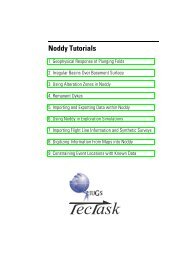Revised Eburnean geodynamic evolution of the ... - Tectonique.net
Revised Eburnean geodynamic evolution of the ... - Tectonique.net
Revised Eburnean geodynamic evolution of the ... - Tectonique.net
You also want an ePaper? Increase the reach of your titles
YUMPU automatically turns print PDFs into web optimized ePapers that Google loves.
S. Perrouty et al. / Precambrian Research 204– 205 (2012) 12– 39 27<br />
Fig. 9. Photographs showing syn-sedimentary normal faults within Sefwi Group volcanoclastic sediments. Some <strong>of</strong> <strong>the</strong>se faults do not affecting <strong>the</strong> youngest layers. O<strong>the</strong>r<br />
faults show post-depositional reverse movement that could reflect <strong>the</strong> start <strong>of</strong> D1. The compass indicates both <strong>the</strong> north (in red) and <strong>the</strong> perspective. (For interpretation <strong>of</strong><br />
<strong>the</strong> references to colour in this figure legend, <strong>the</strong> reader is referred to <strong>the</strong> web version <strong>of</strong> this article.)<br />
4.2.4. D4<br />
In <strong>the</strong> Bogoso gold mine on <strong>the</strong> western side <strong>of</strong> <strong>the</strong> Ashanti Belt,<br />
many small scale shear zones cross-cut F3 folds. Most <strong>of</strong> <strong>the</strong>se shear<br />
zones show sinistral displacements and are interpreted to have<br />
formed in response to a later phase <strong>of</strong> deformation that we identify<br />
as D4. Major splays <strong>of</strong> <strong>the</strong> Ashanti Fault were also likely reactivated<br />
during sinistral shearing associated with D4. At Bogoso, one<br />
<strong>of</strong> <strong>the</strong>se main Ashanti structures is mineralised within a 20–30 m<br />
thick band <strong>of</strong> graphitic phyllites and quartz breccias that separate<br />
Kumasi Group phyllites from <strong>the</strong> Sefwi Group basalts (Fig. 12). At<br />
<strong>the</strong> regional scale, mag<strong>net</strong>ic images show at least two syn-D4 shear<br />
zone generations. The first one is oriented N030 and could correspond<br />
to <strong>the</strong> reactivation <strong>of</strong> D3 thrusts faults, such as <strong>the</strong> Ashanti<br />
Fault. The second is oriented N050 and cross-cuts earlier N030<br />
shears, <strong>the</strong> F3 folds and <strong>the</strong> D3 thrusts within <strong>the</strong> Tarkwa Basin.<br />
In <strong>the</strong> Wassa gold mine, within <strong>the</strong> Sefwi Group on <strong>the</strong><br />
eastern border <strong>of</strong> <strong>the</strong> Tarkwaian sediments, a km scale F4 fold<br />
and associated parasitic folds overprint D3 faults and folds. F4<br />
folds have only been observed at Wassa, although a subvertical<br />
S4 crenulation cleavage was found in many locations on<br />
both sides <strong>of</strong> <strong>the</strong> Tarkwa Basin. Intersection lineations between<br />
S3 and S4 cleavages and F4 folds axis give a plunge approximately<br />
60 ◦ toward 260 ◦ (Fig. 10B). These characteristics correspond<br />
to a NNW-SSE shortening event that could be compatible with<br />
a sinistral shear reactivation <strong>of</strong> existing D3 regional thrust<br />
faults.<br />
4.2.5. D5<br />
The regional architecture <strong>of</strong> <strong>the</strong> Ashanti region was largely built<br />
during D1–D4 but has been modified by two subsequent deformation<br />
events that are observed to overprint D4 structures within <strong>the</strong><br />
Sefwi, Kumasi and Tarkwa groups.<br />
D5 is characterised by recumbent folds associated with a subhorizontal<br />
crenulation cleavage (Fig. 10B). These symmetrical open<br />
to tight folds have a wavelength varying between 5 m and 1 cm in<br />
<strong>the</strong> outcrops we studied. We note a great variability <strong>of</strong> amplitude<br />
between outcrops, varying with <strong>the</strong> lithology and orientation <strong>of</strong><br />
previous structures. F5 folds were mainly observed in Wassa mine,<br />
in <strong>the</strong> NW <strong>of</strong> <strong>the</strong> belt (Pampe gold mine) and in <strong>the</strong> Tarkwaian<br />
sediments around Bogoso. In Damang, many quartz veins were subhorizontal<br />
and parallel to <strong>the</strong> S5 cleavage and formed ei<strong>the</strong>r during<br />
or after D5.<br />
4.2.6. D6<br />
The final deformation event observed in <strong>the</strong> study area presents<br />
as a subvertical crenulation cleavage (S6) that defines open folds<br />
that affects subhorizontal S5 crenulation cleavage. S6 was observed<br />
in Tarkwaian sediments, in <strong>the</strong> Kumasi Group near <strong>the</strong> Akropong<br />
fault and in <strong>the</strong> Wassa gold mine. S6 is subvertical and NW-SE<br />
trending (Fig. 10B) approximately parallel to a series <strong>of</strong> reverse<br />
faults oriented NW-SE identified from <strong>the</strong> mag<strong>net</strong>ic data. These<br />
faults cross-cut all Paleoproterozoic lithologies and earlier fault<br />
and cleavages. They were observed in <strong>the</strong> field at <strong>the</strong> Mpohor and<br />
Damang gold mines. The absence <strong>of</strong> observed overprinting <strong>of</strong> S6,<br />
and its relatively constant orientation, suggest that this D6 event<br />
was likely <strong>the</strong> last significant deformation event to affect <strong>the</strong> area.<br />
4.3. Map<br />
Field observations, combined with geophysical and radar data<br />
have allowed <strong>the</strong> construction <strong>of</strong> a new structural and geological<br />
model <strong>of</strong> <strong>the</strong> region (Fig. 13). This model describes <strong>the</strong> complex<br />
series <strong>of</strong> deformation events that affected <strong>the</strong> Sefwi Group<br />
basement and overlying Kumasi and Tarkwa groups during <strong>the</strong><br />
<strong>Eburnean</strong> orogeny.<br />
4.4. Sefwi Group D1 structures under <strong>the</strong> Tarkwa Basin<br />
During <strong>the</strong> regional geophysical interpretation several significant<br />
differences between features observed in <strong>the</strong> digital elevation<br />
model, radiometric and radar data (which reflect near surface<br />
lithologies and structures, Dickson and Scott, 1997) compared<br />
to <strong>the</strong> aeromag<strong>net</strong>ic data over <strong>the</strong> Tarkwa Basin were observed.<br />
Orientation <strong>of</strong> regional mag<strong>net</strong>ic trends are inconsistent with




